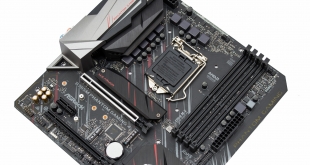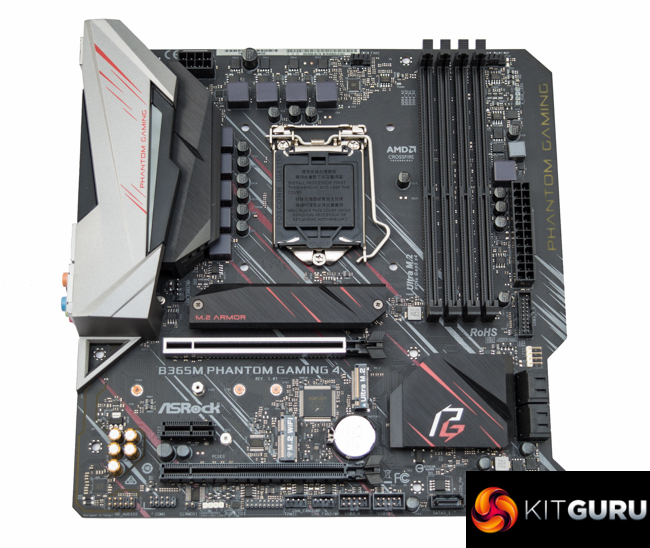
With Intel's processors offering so much of their performance right out of the box, the necessity for overclocking on gaming systems has diminished. Higher Turbo frequencies have meant slimmer and slimmer overclocking gains to the point that motherboards without overclocking are still attractive options. Enter the ASRock B365M Phantom Gaming 4, a gaming motherboard on a seriously affordable budget.

The Intel B365 chipset is the “successor” to the B360 chipset, though in many ways this is in name only. B360 was first manufactured as part of Intel's 14nm Coffee Lake product stack but due to delays on the 10nm process, increased demand for 14nm products led Intel to making difficult decisions on how to prioritise production.
One of those difficult decisions culminated in the “new” B365 chipset which was essentially “turning back” to 22nm silicon to free up 14nm for higher-margin product offerings such as high-end processors. Though for the budget buyer it may not make a significant difference what generation of silicon the motherboard chipset is formed from, it is only the features that really count.
Looking at features Intel's B365 delivers less than B360 in some areas, such as no native USB 3.1 (10Gbps) support or Integrated Wireless functionality. Intel has attempted to balance this out with boosts in other areas by increasing USB port count from 12 to 14, PCI Express lane provision from 12 to 20 and adding SATA/PCIe RAID support.
On the whole there's nothing to be concerned about for budget system builders, most users will struggle to discern the difference and in practice it is only the missing USB 3.1 10Gbps ports that might be noticed, even though some vendors may add this connectivity back with extra hardware at additional cost.
ASRock's specific implementation of B365 is designed with a gaming theme and its micro-ATX form factor choice is something of a rarity these days. ASRock's implementation covers many of the key bases we've come to expect in recent generation motherboard products such as support for dual M.2 drives, M.2 cooling, onboard RGB lighting, additional RGB lighting strip support and a stylised gaming aesthetic.
ASRock has chosen not to put USB 3.1 10Gbps connectivity back on this board, likely to keep costs down, but it does leave a designated M.2 WiFi port ready to be used to get around the lack of native WiFi connectivity on B365. Though again, probably for cost reasons, a WiFi card is not provided as standard but is available as an optional extra purchase for those that require.
Is a gaming motherboard without overclocking a feasible proposition? Let's find out how the ASRock B365M Phantom Gaming 4 gets on during our testing.
| ASRock B365M Phantom Gaming 4 | |
| Form Factor | micro-ATX, 24.4 x 24.2cm |
| CPU Socket | LGA 1151 v2 |
| CPU VRM PWM |
UPI Semiconductor uP9521P (3+2 phase mode) with uP1961S doublers (6+2 effective phase mode) |
| CPU VRM MOSFETs |
NIKOS PK618BA (high-side) & NIKOS PZ0903BK (low-side) |
| Chipset | Intel B365 (22nm) |
| Memory | DDR4, 4 DIMMs, up to 64GB, up to 2666MHz only (no OC) |
| On-board Graphics | Intel UHD Graphics (on supported CPUs) |
| Discrete Graphics | Single Nvidia GPU configurations, AMD CrossFireX or Quad CrossFire X |
| Expansion Slots | 2 x PCIe 3.0 X16 (16X/4X) 1 x PCIe 3.0 X1 1 x M.2 “WiFi” |
| Storage | 2 x M.2 (M2_1 Supports PCIe 3.0 X4 only, M2_2 supports PCIe and SATA III 6Gbps*) 6 x SATA III* *If M2_2 is occupied by SATA device SATA3_0 port is disabled |
| USB | 6 x USB 2.0 (2 Rear, 4 Front, via Intel B365) 7 x USB 3.0 [3.1 Gen1] (5 Rear [1 Type-C], 2 Front, via Intel B365) |
| Networking | 1 x Intel I219V Gigabit LAN |
| Audio | Realtek ALC1200* 7.1 Channel HD Audio *Different from ALC1220 |
| RGB | 2-zone Onboard RGB lighting (rear I/O shield, Motherboard 24pin area) 2 x 12v G R B* 1 x 5v Digital Addressable** *Supports up to 12v@3A/36W **Supports up to 12v@3A/15W |
| Fan Headers | 5, all support auto-detect of 3 or 4pin fans (1 x CPU*, 1 x CPU/W_PUMP**, 3 x CHA/W_PUMP***) *1A, 12W max **2A, 24W max ***2A, 24W max |
| Rear I/O | 1 x PS/2 Mouse/Keyboard Port 1 x HDMI Port 1 x DisplayPort 1.2 1 x Optical SPDIF Out Port 2 x USB 2.0 Ports (Supports ESD Protection) 1 x USB 3.1 Gen1 Type-C Port (Supports ESD Protection) 4 x USB 3.1 Gen1 Ports (Supports ESD Protection) 1 x RJ-45 LAN Port with LED (ACT/LINK LED and SPEED LED) HD Audio Jacks: Rear Speaker / Central / Bass / Line in / Front Speaker / Microphone (Gold Audio Jacks) |
| UEFI | 128Mb AMI UEFI |
 KitGuru KitGuru.net – Tech News | Hardware News | Hardware Reviews | IOS | Mobile | Gaming | Graphics Cards
KitGuru KitGuru.net – Tech News | Hardware News | Hardware Reviews | IOS | Mobile | Gaming | Graphics Cards


